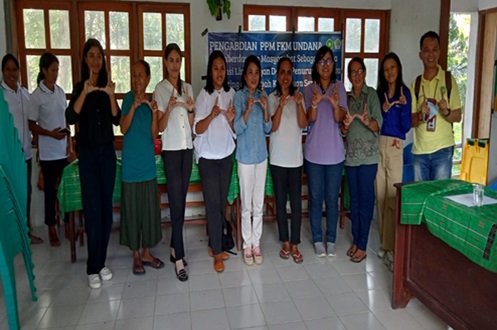Pemberdayaan Masyarakat Sebagai Upaya Mitigasi Lingkungan Dalam Penurunan Angka Stunting di Wilayah Kepulauan Semiringkai Community Empowerment as an Environmental Mitigation Effort in Reducing Stunting Rates in the Semiringkai Islands Region
Main Article Content
Abstract
Stunting is a serious health issue because it has short-term and long-term impacts on public health. NTT Province is the province with the highest stunting cases in Indonesia. Baadale Village, which is in the Rote Ndao Regency, NTT, is also not immune from the problem of stunting in toddlers and targets to be stunting-free by 2023. The problems found are the lack of knowledge of pregnant women and mothers of toddlers regarding environmental sanitation, inconsistent implementation of environmental sanitation and clean and healthy living behavior, poor parenting patterns for toddlers, and limited knowledge and practice of serving varied food menus in improving toddler nutrition. This community service activity is carried out to increase the knowledge and abilities of mothers of children under five years old regarding implementing environmental sanitation, parenting patterns, and serving a variety of food menus to reduce stunting rates. The activities include health education and providing animal protein assistance. The activity results showed an increase in knowledge of 60% in pregnant women and mothers of toddlers after the counseling. Participants were also willing to apply and pass on the knowledge gained to other pregnant women and mothers of toddlers in Baadale Village. Continuous assistance and education need to be carried out to continue to encourage the will and ability of the community, especially pregnant women and mothers of toddlers, to maintain a healthy environment and implement good parenting patterns in terms of feeding, health care, and personal hygiene for children under five years old.
Downloads
Article Details

This work is licensed under a Creative Commons Attribution-ShareAlike 4.0 International License.
Authors who publish with this journal agree to the following terms:
- Any article on the copyright is retained by the author(s).
- Author grant the journal, right of first publication with the work simultaneously licensed under a Creative Commons Attribution License that allows others to share work with acknowledgment of the work authors and initial publications in this journal.
- Authors are able to enter into a separate, additional contractual arrangements for non-exclusive distribution of published articles of work (eg, post-institutional repository) or publish it in a book, with acknowledgment of its initial publication in this journal.
- Authors are permitted and encouraged to post their work online (e.g., in institutional repositories or on their websites) prior to and during the submission process, as can lead to productive exchanges, as well as earlier and greater citation of published work.
- The article and any associated published material is distributed under the Creative Commons Attribution-ShareAlike 4.0 International License
References
Anwar, S., Winarti, E. & Sunardi, S. 2022. Systematic Review Faktor Risiko, Penyebab Dan Dampak Stunting Pada Anak. Jurnal Ilmu Kesehatan, 11, 88-94. https://doi.org/10.32831/jik.v11i1.445
Archda, R. & Tumangger, J. 2019. Hulu-hilir penanggulangan stunting di Indonesia. JPI : Jurnal of Political Issues 1(1) 1-9. http://dx.doi.org/10.33019/jpi.v1i1.2
De Onis, M. & Branca, F. 2016. Childhood stunting: a global perspective. Maternal & child nutrition, 12, 12-26. https://doi.org/10.1111/mcn.12231
Devi, L. Y., Andari, Y., Wihastuti, L. & Haribowo, K. 2020. Model sosial-ekonomi dan ketahanan pangan rumah tangga di Indonesia. Jurnal Ekonomi Dan Pembangunan, 28, 103-115.
Diniyyah, S. R. & Nindya, T. S. 2017. Asupan energi, protein dan lemak dengan kejadian gizi kurang pada balita usia 24-59 bulan di Desa Suci, Gresik. Amerta Nutrition, 1, 341-350. https://doi.org/10.20473/amnt.v1i4.2017.341-350
Haskas, Y. 2020. Gambaran stunting di Indonesia: literatur review. Jurnal Ilmiah Kesehatan Diagnosis, 15, 154-157.
Illahi, R. K. & Muniroh, L. 2016. Gambaran Sosio Budaya Gizi Etnik Madura Dan Kejadian Stunting Balita Usia 24–59 Bulan Di Bangkalan. Media Gizi Indonesia, 11, 135-143. https://doi.org/10.20473/mgi.v11i2.135-143
Johariyah, A. & Mariati, T. 2018. Efektivitas penyuluhan kesehatan reproduksi remaja dengan pemberian modul terhadap perubahan pengetahuan remaja. Jurnal Manajemen Kesehatan Yayasan RS. Dr. Soetomo, 4, 38-46. http://dx.doi.org/10.29241/jmk.v4i1.100
Junias, M. S., Toy, S. M., Ndoen, E. M., Manurung, I. F., Doke, S. & Keraf, M. K. 2023. Promosi Kesehatan Reproduksi Remaja Dan Manajemen Kebersihan Menstruasi Pada Remaja Putri Sekolah Menengah Pertama. Abdimas Galuh, 5, 69-78. http://dx.doi.org/10.25157/ag.v5i1.8879
Kemenkes, R. 2021. Hasil Studi Status Gizi Indonesia (SSGI) Tingkat Nasional, Provinsi, dan Kab/Kota Tahun 2021. Jakarta: Kementerian Kesehatan Republik Indonesia.
Littik, S. K., Manongga, S. P., Ndoen, E. M., Elim, R. V. & Ledo, J. P. 2023. Peningkatan Pengetahuan dan Praktek Kebersihan Diri saat Menstruasi Siswi Sekolah Menengah Pertama: Increasing Knowledge and Practice of Personal Hygiene when Menstruation among First High School Female Students. PengabdianMu: Jurnal Ilmiah Pengabdian kepada Masyarakat, 8, 65-72. https://doi.org/10.33084/pengabdianmu.v8i1.4048
Mawardi, K. J. R. 2020. Perempuan Rote Meniti Tradisi. Umbara, 5, 162-165.
Ndolu, J. C., Nabuasa, E. & Sahdan, M. 2022. Analysis of Risk Factors for Stunting Incidence in Children Under Two Years in Helebeik Village, Lobalain District, Rote Ndao Regency. Lontar: Journal of Community Health, 4, 115-124. https://doi.org/10.35508/ljch.v4i2.4402
Ni’mah, C. & Muniroh, L. 2015. Hubungan tingkat pendidikan, tingkat pengetahuan dan pola asuh ibu dengan wasting dan stunting pada balita keluarga miskin. Media Gizi Indonesia, 10, 84-90. https://doi.org/10.20473/mgi.v10i1.84-90
Olsa, E. D., Sulastri, D. & Anas, E. 2018. Hubungan sikap dan pengetahuan ibu terhadap kejadian stunting pada anak baru masuk Sekolah Dasar di kecamanatan Nanggalo. Jurnal Kesehatan Andalas, 6, 523-529.
Rahmadhita, K. 2020. Permasalahan stunting dan pencegahannya. Jurnal Ilmiah Kesehatan Sandi Husada, 9, 225-229.
Soeracmad, Y. S. Y. 2019. Hubungan Sanitasi Lingkungan Rumah Tangga Dengan Kejadian Stunting Pada Anak Balita Di Puskesmas Wonomulyo Kabupaten polewali Mandar Tahun 2019. J-KESMAS: Jurnal Kesehatan Masyarakat, 5, 138-150.
